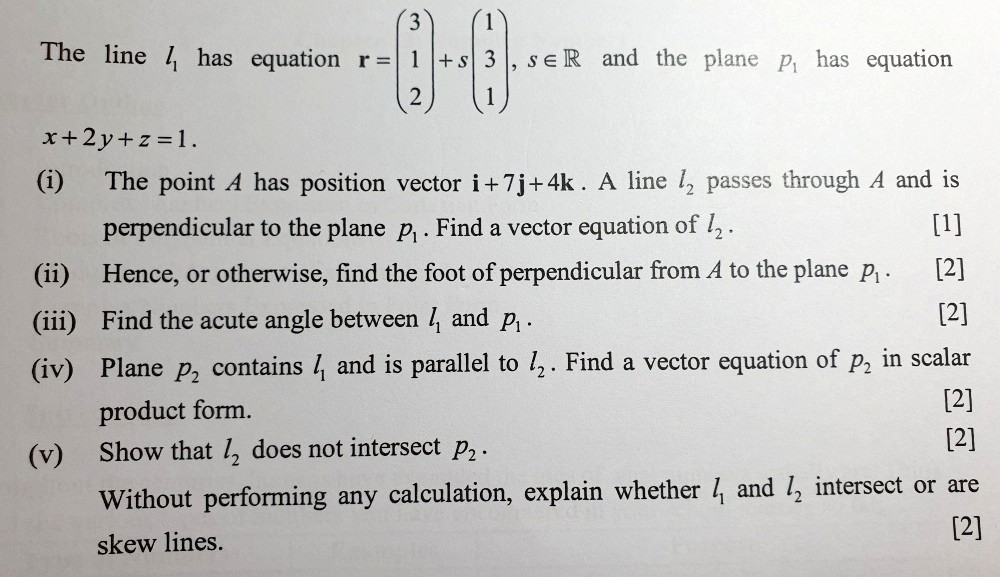Ask Singapore Homework?
Upload a photo of a Singapore homework and someone will email you the solution for free.

Question
junior college 2 | H2 Maths
No Answers Yet
Anyone can contribute an answer, even non-tutors.

I need help with part (v)
r•(-1 0 1) = -1
Equation of l2:
l2: r = (1 7 4) + λ(1 2 1) , λ ∈ R
Any point on l2 can be represented by the position vector (1 7 4) + λ(1 2 1) = (1+λ 7+2λ 4+λ)
Since l2 is parallel to p2, if l2 intersects p2,
It will lie completely in p2. Thus any point on l2 will have a position vector that satisfies the equation of p2.
But,
(1+λ 7+2λ 4+λ)•(-1 0 1)
= -1 - λ + 4 + λ
= 3 ≠ -1
So no points on l2 can satisfy the equation of p2. This means l2 doesn't lie in p2 and thus they do not intersect.
For l1 and l2, their direction vectors are not parallel. So they are not parallel to each other.
l2 and p2 are parallel to each other but do not intersect. As p2 contains l1, it follows that l2 and l1 do not intersect as l2 doesn't even intersect p2.
Since l1 and l2 do no intersect and are not parallel, they are a pair of skew lines.
(3 1 2)•(1 2 1) = 7
Which led to your equation r•(1 2 1) = 7
You used the direction vector of l2 for your normal vector of p2.
However,question says that l2 is parallel to p2. So is its direction vector (1 2 1).You can't use a vector that is parallel to p2 as your normal vector since you need one that is perpendicular.
What I've described in the method yesterday was to cross two vectors parallel to the plane (but not parallel to each other)to obtain a vector that is perpendicular to the plane.
As l1 lies in p2, it is parallel to p2. So is its direction vector (1 3 1).
l2 and its direction vector (1 2 1) are also parallel to p2.
You now have the two vectors required, (1 3 1) and (1 2 1). They are parallel to p2 but not to each other.
Crossing them , you get
(1 2 1) x (1 3 1) = (-1 0 1)
Now dot this with (3 1 2),
(3 1 2)•(-1 0 1) = -1
So equation of p2 is r•(-1 0 1) = -1
For example,
Let say for iv), you cross the other way round :
(1 3 1) x (1 2 1) = (1 0 -1)
Now dot this with (3 1 2),
(3 1 2)•(1 0 -1) = 1
So equation of p2 is r•(1 0 -1) = 1
Notice that :
r•(1 0 - 1) = 1
Then r• (-(-1 0 1)) = 1
-r•(-1 0 1) = 1
r•(-1 0 1) = -1
You can easily convert one into the other by changing the sign. It's like saying 2x = 3 is the same as -2x = -3


